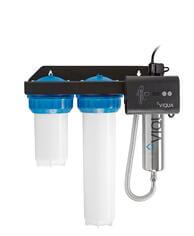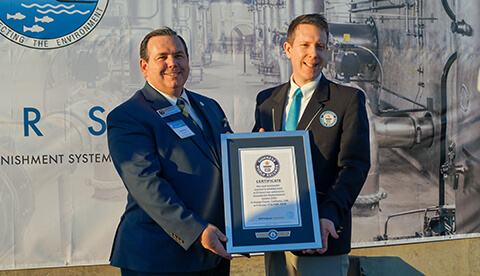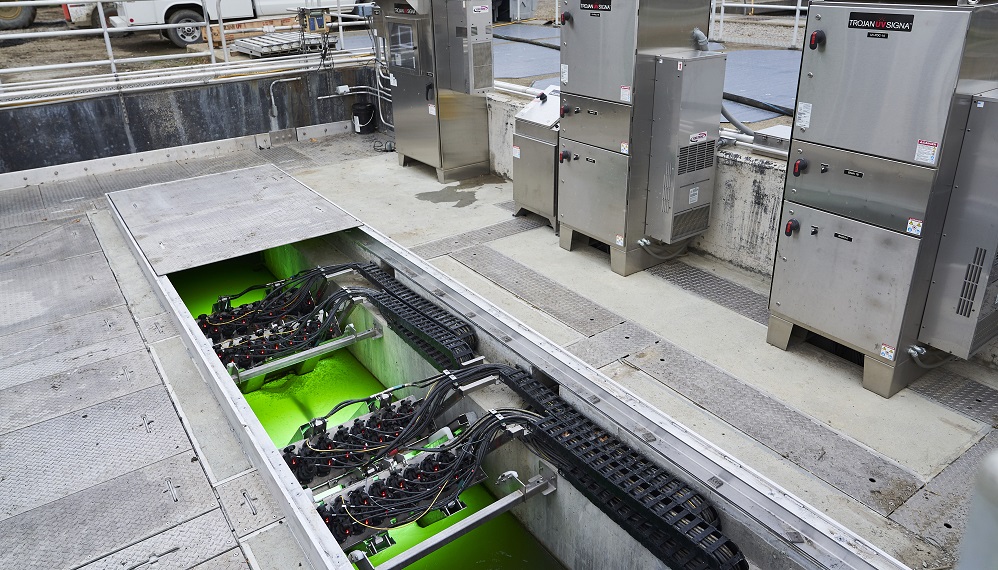Treating Well Water

You’ve made the choice to treat your well water, great! Now you know your family will be protected from possible waterborne pathogens despite seasonal run-off, the threat of leaking septic tanks, or heavy rains and flooding. Adding inactivation adds to your peace of mind.
Chlorine vs. UV
 There are, of course, different approaches to achieving inactivation. The oldest and most familiar is chlorination or simply adding chlorine (bleach) to your water. This approach has been used by cities and municipalities for years and years. A newer technology that is increasingly being adopted is ultraviolet (UV) inactivation.
There are, of course, different approaches to achieving inactivation. The oldest and most familiar is chlorination or simply adding chlorine (bleach) to your water. This approach has been used by cities and municipalities for years and years. A newer technology that is increasingly being adopted is ultraviolet (UV) inactivation.
Ironically, the science behind UV is just as old as chlorine, but ultraviolet technology has recently come into the mainstream, largely for one reason- adding a chemical to drinking water creates additional problems! The first and perhaps less concerning one has been known all along: your water will taste and smell like chlorine. Secondly, other potentially more harmful chemicals can be produced as a by-product of the inactivation process. Understanding of the detrimental impact of these treatment by-products continues to grow. UV, on the other hand, is chemical-free and adds no flavor or odor to your water*. Nevertheless, you may be faced with making a choice between these two treatment techniques. So, how do you decide? Other key considerations will be effectiveness, equipment needs, and maintenance demands.
Effectiveness
Both chlorination and ultraviolet inactivation are effective against harmful bacteria that can be found in well water. However, there are other microbes – not just bacteria – that can find their way into well water and cause very serious illness. You will also want to address protozoa like Cryptosporidium and Giardia. The latter is especially resistant to chlorine but easily managed with UV. Conversely, some waterborne viruses require higher UV doses to inactivate. In short, you will want protection from as many “bugs” as possible.
Equipment Needs
For inactivation UV, you will be buying a UV water treatment system and likely some form of pre-treatment, which is necessary to ensure optimal functioning of the UV. Pre-treatment can be as simple as including a sediment filter and perhaps a carbon filter, which nowadays often come as one unit. If your water also contains hardness minerals, you will likely also require a water softener. Luckily, there are many additional benefits to softening your water! And for some, there may also be a need to remove iron and manganese. Every circumstance is unique, so you will want to reach out to a water treatment professional to discuss a tailored approach. As a starting point this water treatment selector tool can help you understand your particular needs.
With chlorine inactivation, you will require a chemical feed pump, a solution tank, and a holding tank. The size of these will depend on the size of your home/family and water usage. For optimal performance, you should also add in a static mixer. That’s the chlorination part. Bear in mind that you will still need a water softener for hardness, if that’s an issue in your water. Lastly, you will definitely want to add a carbon filter to avoid tasting the chlorine. By adding more chlorine, this set-up can handle iron-containing waters, but an additional filtration step will be required.
Maintenance
In order to keep any equipment running properly some maintenance will always be required. With a UV system, that can be as minimal as changing the lamp annually and cleaning the quartz sleeve. So how much time is that? Maybe one hour a year. In some cases, it may be necessary to clean the quartz sleeve once every 3-4 months, but that’s only if the water entering the UV system doesn’t fully meet the manufacturer’s specifications.
With a chlorinator, besides the time spent regularly refreshing and monitoring the chemical supply, you should thoroughly clean the system twice a year and give it a complete inspection for any signs of corrosion. Just like chlorine is hard on the “bugs”, it can be hard on your pump and other metals too.
Comparison
The following chart compares these two commonly used approaches – UV and constant chlorination. For many, getting effective inactivation without the use of chemicals is enough to sway their decision. But it is easy to see how the low maintenance requirements of a UV system would totally tip the scales.
| Key Considerations | Chlorine | UV Inactivation |
| Approach | Chemical | Physical |
|
Effectiveness vs Bacteria vs Protozoa vs Viruses |
YES Cryptosporidium highly resistant YES |
YES YES Some viruses require higher UV doses |
| Equipment Needs |
Chemical feed pump Solution tank Holding Tank w/ static mixer Carbon filter |
Pre-treatment must include sediment and carbon filter and may include water softener and iron removal. No residual effect.
|
| Maintenance |
Regular chemical handling Thorough cleaning twice/year Cleaning all surfaces showing corrosion Cleaning any clogged injection points |
Yearly lamp replacements Occasional quartz sleeve cleaning or replacement |
*In rare circumstances, low levels of sulfur in source water may become detectable due to the UV system.
Featured Posts
First Potable Reuse Demo Plant in Europe uses Trojan UV AOP
Trojan is proudly part of the Consorci d'Aigües Costa Brava Girona’s AIGUANEIX water purification project Trojan Technologies is excited to share that we’re part of Diputació de Girona and Consorci d'Aigües Costa Brava Girona’s AIGUANEIX water reuse pilot project at...
Trojan Technologies Opens First U.S. Distribution Facility in Grand Rapids, Michigan
On March 3, 2025, Trojan Technologies celebrated the grand opening of its first U.S. distribution center in Grand Rapids, Michigan. This strategic expansion underscores the company's dedication to enhancing customer experience and optimizing the delivery of its...
Veralto Enters Agreement to Purchase AQUAFIDES
WALTHAM, Mass., Feb. 17, 2025 /PRNewswire/ -- Veralto Corporation (NYSE: VLTO) (the "Company"), a global leader in essential water and product quality solutions dedicated to Safeguarding the World's Most Vital Resources™, announced the signing of a definitive...







